
As the share of renewable sources rises, there will be more variability and less flexibility in electricity generation.
Alternative sources of flexibility to balance electricity demand and supply can draw on flexible demand, either through localised energy storage or changing the timing of energy-using activities. Both approaches require a thorough understanding of the timing of human activities in the home and on the move as well as the timing of heating demand.
In the case of activity re-timing, current patterns are largely determined by the legacies of historical systems [1]. The social and institutional rhythms that drive energy using patterns need to change to provide this type of flexibility. For instance, the timing of school energy use is embedded in city and regional rhythms, as it is connected to the routines of work, home, and everyday life [2].
The potential of residential demand flexibility is large but comes with significant challenges [3]. The UK roll out of smart meters is behind its original schedule, but well-advanced. Smart meter potential costs and benefits are well-understood [4] and they are an essential, but not sufficient, enabler of increased residential sector demand response. They can facilitate demand flexibility, especially where there are new large electricity loads in heating and vehicle charging that can be flexed in time. With the exception of cheap-rate night-time tariffs, legacy systems for electricity system balancing have generally not used residential demand flexibility. Change will be needed in business models and regulation, but system flexibility needs may not always be well-aligned with user needs [5].
Use of electric vehicle batteries in principle offers a very large potential to contribute to home energy storage and electricity system balancing, either through changing the timing of charging and/or vehicle-to-grid technology. The latter can reduce consumer costs significantly [6].At moderate penetrations of electric vehicles, user diversity means on-demand home charging is not expected to create major problems for the electricity system balancing. However, arrival times by car from work have a noticeable impact on the scheduling of activities in the home and distribution of evening peak demand. And charging based on time of use tariffs has risks of coordination induced load spikes [7].
Understanding and using the potential of heating flexibility will be important. As more households adopt heat pumps, winter demand for electricity will increase. Heat pump flexibility in practice will be difficult due to the heterogeneity of the heat pump stock and the physical characteristics of heat pumps themselves [8]. Occupant buy-in will be crucial to the acceptance of heat pump demand response and the limits of tolerable temperature change are still unknown [9]. Heat storage, in both fabric and hot water, can also make a significant contribution to flexibility in buildings [10]. For most homes a flexibility rating could be generated from half hourly smart meter and internal temperature data. This could be added to the empirical EPC, enabling estimation of heat pump demand at peak [11].
Flexibility in use can contribute to diurnal system balancing, but the seasonality of demand will be strong, and will need to be addressed by chemical and/or thermal energy storage [12], see Energy Systems. Successful demand response business models will need to improve understanding of the drivers of time use. New metrics of time-of-day price elasticity and non-price elasticity are more accurate than traditional average price elasticity of demand [13 ,14].
In some cases, community energy actors are supporting local energy innovation to facilitate demand side response, but changes in supply licensing are needed if these opportunities are to be fully exploited [4]. Peer-to-peer trading directly between prosumers, can help system balancing, whilst encouraging the active participation of citizens in the energy transition [15].
Evidence
- Flexibilities in energy supply and demand: Legacies and lessons from the past | Research paper, 2021
- Conceptualising flexibility: Challenging representations of time and society in the energy sector | Research paper, 2020
- EDRC & CREDS response to Ofgem consultation: Engaging domestic consumers in energy flexibility | Research paper, 2023
- Household electricity demand, the intrinsic flexibility index and UK wholesale electricity market prices | Research paper, 2020
- Beware the value gap: Creating value for users and for the system through innovation in digital energy services business models | Research paper, 2021
- Vehicle to grid: driver plug-in patterns, their impact on the cost and carbon of charging, and implications for system flexibility | Research paper, 2023
- I’m coming home (to charge): The relation between commuting practices and peak energy demand in the United Kingdom | Research paper, 2022
- Ecology of heat pump performance: A socio-technical analysis | Research paper, 2019
- Demand response beyond the numbers: A critical reappraisal of flexibility in two United Kingdom field trials | Research paper, 2021
- Energy demand and its temporal flexibility: Approaches, criticalities and ways forward | Research paper, 2022
- An empirical energy demand flexibility metric for residential properties | Research paper, 2022
- Meeting UK heat demands in zero emission renewable energy systems using storage and interconnectors | Research paper, 2020
- Household electricity demand, the intrinsic flexibility index and UK wholesale electricity market prices | Research paper, 2022
- Time-varying price elasticity of electricity demand | Research paper, 2023
- Pricing decisions in peer-to-peer and prosumer-centred electricity markets: Experimental analysis in Germany and the United Kingdom | Research paper, 2022
Banner photo credit: Pat Whelen on Unsplash
